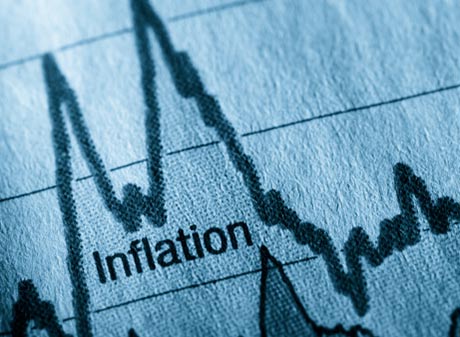The Fed’s Inflation Target: Why 2 Percent?
 Getty/JLGutierrez
Getty/JLGutierrez
A recent Open Vault post explained that the Federal Reserve has a so-called dual mandate for monetary policy—maximum employment and price stability.
The latter, price stability, is often interpreted to mean low and stable inflation. To meet the price stability objective, Federal Reserve policymakers target an inflation rate of 2 percent.
This post discusses some basics on inflation, such as what inflation is and how it is measured. It also discusses the Fed’s inflation target, how it came to be, what it means and why the Fed targets a positive number instead of zero percent inflation.
Some Basics on Inflation
Inflation is a general, sustained upward movement of prices for goods and services in an economy. (Think overall prices—not the price of a single good.)
The inflation rate can be estimated using a price index, which gives a sense of how overall prices in the economy are evolving. A common calculation is the percentage change from a year ago. For instance, if a price index is 2 percent higher than a year ago, that would indicate an inflation rate of 2 percent.
One index that economists and policymakers like to look at is the price index for personal consumption expenditures (PCE). Produced by the Bureau of Economic Analysis, this index accounts for prices that U.S. consumers pay for a wide range of goods and services. It includes various prices associated with cars, food, clothing, housing, health care and so on.
For a crash course on price indexes, check out another recent blog post.Monetary Policy and Inflation
The Federal Open Market Committee, or FOMC, is the main monetary policymaking body of the Federal Reserve. You may have heard of the FOMC taking policy actions, such as lowering or raising interest rates, in response to economic conditions and in an effort to achieve the Fed’s dual mandate.
Monetary policy decisions depend on a wide range of data, but for simplicity, let’s just focus on inflation and the target for the federal funds rate.
- Too high? If inflation is running persistently too high, the FOMC might raise the target for the federal funds rate in an effort to bring inflation back down.
- Too low? In contrast, if inflation is running persistently too low, the FOMC might reduce the target for the federal funds rate in an effort to bring inflation back up.
How the Fed’s 2 Percent Inflation Target Came to Be
As mentioned earlier, the FOMC interprets an inflation rate of 2 percent as consistent with price stability. As such, the FOMC adopted an explicit inflation target of 2 percent in January 2012.
In the 2016 version of the statement on longer-run goals (PDF), the FOMC clarified that its inflation target is symmetric (in other words, it isn’t a floor or a ceiling). The FOMC added: “The Committee would be concerned if inflation were running persistently above or below this objective.”
Although the FOMC didn’t explicitly name an inflation target until 2012, St. Louis Fed President James Bullard has argued that the U.S. had “an implicit inflation target of 2 percent after 1995.” (See Bullard’s presentation from Sept. 12, 2018. In that presentation, he also noted that 2 percent became an international standard in the inflation targeting era that began in the 1990s.)
More Details about the Inflation Target
The Fed’s target is based on the annual change in the overall, or “headline,” PCE price index. As Bullard wrote in a 2012 Regional Economist article, “The FOMC will target the headline inflation rate as opposed to any other measure (e.g., core inflation, which excludes food and energy prices) because it makes sense to focus on the prices that U.S. households actually have to pay.”
Furthermore, the inflation target is meant to be reached over a longer period of time; inflation doesn’t have to be 2 percent all the time. In that same article, Bullard explained the period over which the FOMC would aim to hit the target.
“To clarify, this does not mean inflation must be 2 percent in the short term; rather, monetary policy should be set so that inflation moves toward the target over time and, in the absence of unpredictable changes in either supply or demand, would reach 2 percent in the medium term,” he wrote.
The figure below shows headline PCE inflation (the measure that the Fed targets) over the past couple decades. It also includes two measures that people sometimes look at to get a sense of underlying inflation trends:
- Core PCE inflation: This measure excludes food and energy prices.
- Trimmed mean PCE inflation: This measure, created by the Federal Reserve Bank of Dallas (PDF), excludes a certain portion of the items at the extremes—that is, the items with prices that increased the most or decreased the most in that particular month.
Why the FOMC Targets a Positive Number for Inflation
You might be wondering why the FOMC would target a positive rate of inflation. Why not zero? Or a negative number?
David Wheelock, a St. Louis Fed group vice president and deputy director of research, addressed these questions in a 2017 podcast. He acknowledged that there isn’t a general agreement among economists, but he laid out three arguments that people make for having a positive inflation target.
1. Measurement Bias
“[O]ne reason that central banks like the Fed have tended to settle on a numerical target that’s above zero is that measuring inflation precisely is very difficult,” Wheelock said. He explained that the price indexes that are used to estimate inflation don’t necessarily include all goods and services in an economy.
Furthermore, these indexes have a slight upward bias. “So, when the observed rate of inflation is, say, 1 or 2 percent … the true measure is actually probably lower than that, closer to zero,” he explained.
2. Room to Cut Interest Rates
Another reason that some people give for having a positive inflation target is that interest rates and inflation tend to be proportional, Wheelock noted. That means that a higher inflation rate tends to be associated with higher interest rates.
“A higher level of interest rates gives the Fed a little more room to cut in the event of a recession,” he said. “So it’s a bit of a cushion that allows monetary policy to operate a little more through its traditional interest rate channel.”
3. Avoiding Deflation
A third reason that Wheelock discussed for targeting a positive number relates to providing insurance against deflation. Deflation is a general, sustained downward movement of prices for goods and services.
“[S]ome people think that the effect of deflation of a given size would be more harmful for the economy than a positive rate of inflation of the same number,” Wheelock said.
“So, in other words, the costs of a negative 2 percent inflation rate, or a 2 percent deflation rate, would be higher than the costs of a 2 percent positive inflation rate. So, you want to err on the side of having a positive number,” he explained.
Ultimately, Why Is an Inflation Target Important?
The FOMC’s statement on longer-run goals and monetary policy strategy (PDF) explains the importance of announcing an inflation target: Doing so “helps keep longer-term inflation expectations firmly anchored.”
Why do inflation expectations matter? They are important for actual inflation, as Bullard explained in a 2016 Regional Economist article. “Modern economic theory says that inflation expectations are an important determinant of actual inflation,” he wrote.
He further explained: “Firms and households take into account the expected rate of inflation when making economic decisions, such as wage contract negotiations or firms’ pricing decisions. All of these decisions, in turn, feed into the actual rate of increase in prices.”
Therefore, stating an inflation goal—and maintaining credibility with respect to that goal—helps the FOMC manage the public’s expectations when it comes to inflation. In turn, this helps in achieving price stability as per the Fed’s mandate.
Additional Resources
- Open Vault: A Look at the Fed’s Dual Mandate
- Open Vault: Here’s the Difference between Fiscal Policy and Monetary Policy
- Timely Topics podcast: Monetary Policy Minutes: What Is Monetary Policy?
This blog explains everyday economics and the Fed, while also spotlighting St. Louis Fed people and programs. Views expressed are not necessarily those of the St. Louis Fed or Federal Reserve System.
Email Us


